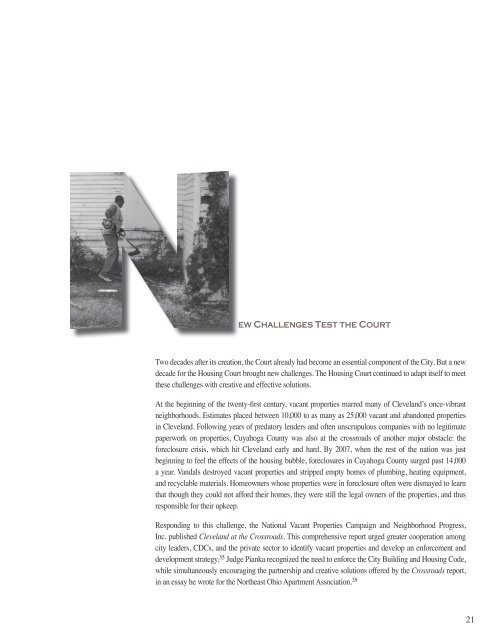Cleveland Housing Court
A detailed look at the 35th Anniversary of the Cleveland Municipal Court's Housing Division.
A detailed look at the 35th Anniversary of the Cleveland Municipal Court's Housing Division.
You also want an ePaper? Increase the reach of your titles
YUMPU automatically turns print PDFs into web optimized ePapers that Google loves.
ew Challenges Test the <strong>Court</strong><br />
Two decades after its creation, the <strong>Court</strong> already had become an essential component of the City. But a new<br />
decade for the <strong>Housing</strong> <strong>Court</strong> brought new challenges. The <strong>Housing</strong> <strong>Court</strong> continued to adapt itself to meet<br />
these challenges with creative and effective solutions.<br />
At the beginning of the twenty-first century, vacant properties marred many of <strong>Cleveland</strong>’s once-vibrant<br />
neighborhoods. Estimates placed between 10,000 to as many as 25,000 vacant and abandoned properties<br />
in <strong>Cleveland</strong>. Following years of predatory lenders and often unscrupulous companies with no legitimate<br />
paperwork on properties, Cuyahoga County was also at the crossroads of another major obstacle: the<br />
foreclosure crisis, which hit <strong>Cleveland</strong> early and hard. By 2007, when the rest of the nation was just<br />
beginning to feel the effects of the housing bubble, foreclosures in Cuyahoga County surged past 14,000<br />
a year. Vandals destroyed vacant properties and stripped empty homes of plumbing, heating equipment,<br />
and recyclable materials. Homeowners whose properties were in foreclosure often were dismayed to learn<br />
that though they could not afford their homes, they were still the legal owners of the properties, and thus<br />
responsible for their upkeep.<br />
Responding to this challenge, the National Vacant Properties Campaign and Neighborhood Progress,<br />
Inc. published <strong>Cleveland</strong> at the Crossroads. This comprehensive report urged greater cooperation among<br />
city leaders, CDCs, and the private sector to identify vacant properties and develop an enforcement and<br />
development strategy. 35 Judge Pianka recognized the need to enforce the City Building and <strong>Housing</strong> Code,<br />
while simultaneously encouraging the partnership and creative solutions offered by the Crossroads report,<br />
in an essay he wrote for the Northeast Ohio Apartment Association. 35<br />
21



